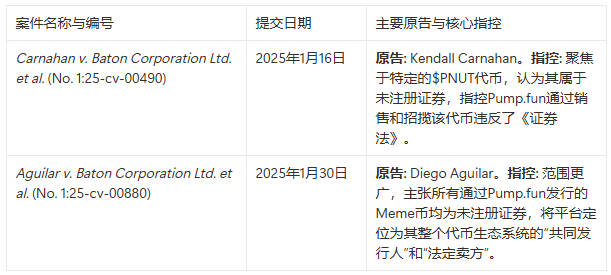This event reveals the inherent contradictions of the Meme coin market and the vulnerability of decentralized finance's reliance on centralized platforms, serving as an important warning for the future development of the cryptocurrency industry.
Written by: Luke, Mars Finance
Once, the Meme coin issuance platform Pump.fun on the Solana blockchain was an ever-open digital amusement park, a wealth-generating machine that made money daily. Here, anyone could create a new cryptocurrency in just a few minutes for less than $2, diving into a frenzy of speculation. However, the noise has abruptly ceased. Today, this amusement park's lights have gone out, falling into silence. It not only faces multiple class action lawsuits in the New York federal court but also has its most important promotional platform—its official account on social media platform X—permanently banned.

The sudden fall of Pump.fun is not an isolated case; it is more like a prism reflecting the profound internal contradictions behind the Meme coin craze. This is a collision between an unregulated, gamified financial experiment and the cold realities of securities law, the life-and-death power of centralized platforms, and the harsh laws of market economics. Is this digital carnival merely a fleeting bubble, or does it herald the rise of a new, untamable force of market speculation? Its trajectory of rise and fall provides us with an excellent dissection sample.
I. Anatomy of the Meme Factory: Rise and Decay
The rise of Pump.fun stems from its extreme "democratization" of the financial speculation threshold, while its downfall is rooted in the inherent systemic flaws of this model.
"Innovation": Opening the Casino Doors to Everyone
The core mechanism of Pump.fun lies in its simplification of the token creation process on the Solana blockchain, creating a one-stop platform for Meme coin creation and trading. Its soul is a mathematical model known as the "Bonding Curve." Under this model, the price of tokens automatically rises with increased purchasing demand, creating huge incentives for early participants and providing a continuous fuel for speculative frenzy. This mechanism was packaged as a form of "fair issuance," quickly making Pump.fun known as the "Meme coin casino" among insiders.
This casino business was exceptionally booming. The platform built a lucrative business model by charging a 1% exchange fee on each transaction and a fee of 1.5 SOL for tokens that successfully "graduate" (i.e., reach a certain market cap and list on decentralized exchanges). By early 2025, the platform had accumulated fees close to $500 million, with a single-day revenue peak exceeding $15 million, making it a highly efficient money-printing machine.
The Internal Decay: A System Built on Deceit
However, beneath the prosperous facade lies a shocking reality. A devastating report released by risk analysis firm Solidus Labs revealed that as much as 98.6% of the tokens issued on Pump.fun exhibited typical "Pump-and-Dump" scam characteristics, ultimately plummeting to zero and becoming worthless. This data completely tore away the platform's facade of "innovation" and "fairness," exposing its essence as an industrial-scale breeding ground for fraud.
The relationship between the platform's business model and fraudulent activities is not merely one of tacit approval but forms a deep symbiosis. Pump.fun's revenue is directly tied to the issuance and trading volume of tokens on its platform. Since the vast majority of transactions stem from fraudulent pump-and-dump schemes, the platform's nearly $500 million in revenue is essentially derived from facilitating these scams. This creates a distorted incentive mechanism: in pursuit of maximizing revenue, the platform inevitably prioritizes lowering thresholds and increasing trading volume over strengthening security checks and protecting investors. This renders its so-called "fair issuance" promise particularly hollow.
The platform's vulnerabilities had long been apparent. In May 2024, a former employee exploited privileged access to steal approximately $1.9 million in assets through a flash loan attack, exposing significant internal control flaws. In February 2025, its official X account was hacked to promote scam tokens, further highlighting its inadequate defenses against external risks. Legal documents also accused the platform of profiting massively in an environment rife with illegal and anti-social content, adding a layer of moral and reputational stain.
II. Legal Reckoning: When Meme Coins Encounter the Howey Test
When wild financial experiments touch the legal red line, a reckoning is inevitable. In January 2025, two key class action lawsuits were filed in the Southern District of New York federal court, placing Pump.fun and its underlying entities and founders in the defendant's seat.
Legal Siege
The lawsuits were initiated by law firms such as Wolf Popper LLP and Burwick Law, with defendants including Pump.fun's UK operating entity Baton Corporation Ltd., and its founders Alon Cohen, Dylan Kerler, and Noah Bernhard Hugo Tweedale. The core accusation is that Pump.fun promoted and sold a large number of unregistered securities through its platform, openly violating the 1933 U.S. Securities Act. The plaintiffs demand the platform refund all investors' purchase amounts and compensate for the resulting economic losses, amounting to nearly $500 million.

The central legal weapon in this lawsuit is the "Howey Test," established in 1946, which serves as the gold standard for determining whether an investment constitutes a "security." The plaintiffs' argument is highly disruptive: they contend that Pump.fun is far from a neutral technology tool provider; rather, it is an active participant in token issuance and sales, acting as a "statutory seller" and "co-issuer."
This argument is supported by the fact that Pump.fun deeply controls the entire process from token creation to trading: it provides standardized token creation tools, controls liquidity and pricing through the bonding curve mechanism, and actively promotes these tokens using its platform and influencer partnerships. The lawsuit describes this model as a "new evolution of Ponzi and pump-and-dump schemes." This legal strategy marks a significant evolution in cryptocurrency litigation. In the past, regulators typically targeted individual token issuers (such as the SEC's lawsuit against Ripple), but faced with thousands of anonymous creators on Pump.fun, this approach is inefficient. Now, the plaintiffs choose to strike at the heart of the matter—holding the platform itself as the responsible party. If this logic holds in court, then any "one-click token issuance" platform that provides standardized tools, controls pricing mechanisms, and participates in promotion could be deemed an unregistered securities seller. This would fundamentally destroy the business model of such "issuance platform as a service."
Caught Between Two Regulatory Eras
This lawsuit occurs at a time of dramatic transformation in U.S. cryptocurrency regulatory policy. It arises at the tail end of the "enforcement-centric" era led by former SEC Chairman Gary Gensler, characterized by lawsuits against giants like Coinbase and Binance, viewing most crypto assets as potential securities. However, the case will be heard under the leadership of a new government and the new SEC Chairman Paul Atkins, who has clearly stated a more favorable stance towards cryptocurrencies and plans to establish a clearer regulatory framework. Therefore, the outcome of this lawsuit not only concerns the fate of Pump.fun but will also serve as a barometer for how the U.S. judicial system balances two radically different regulatory philosophies.
III. Signal Disruption: The Disorientation After Platform Ban
If the legal lawsuits represent a fundamental challenge to its business model, then the ban from social media is a direct severing of its lifeline.
Digital Guillotine
The official X account of Pump.fun and the personal account of its founder Alon Cohen have been suspended, which is not an isolated incident but part of a broader cleanup action by the X platform against a series of Meme coin-related accounts (including GMGN, BullX, etc.). There are various speculations about the reasons for the ban. The most credible explanation is that platforms like Pump.fun may have violated the terms of service of X by using shared or "black market" APIs to drive their trading tracking and "sniping" bots. Another possibility is that, facing increasing legal risks and fraud allegations, the X platform chose to proactively cut ties to reduce its own platform liability.
This incident profoundly reveals the centralization paradox of so-called "decentralized finance." Although Pump.fun is built on the decentralized Solana blockchain, its lifeblood—user acquisition, community interaction, and viral marketing—completely relies on the centralized social platform X. As one CEO shared on Reddit, losing the X account is akin to being "silenced overnight." This exposes a fatal weakness in the entire Web3 ecosystem: its social and distribution layers are still firmly controlled by a few tech giants.
Community Division and Narrative Shift
The collapse of the platform has triggered vastly different reactions within the community. Some revel in schadenfreude, believing that Pump.fun was like a parasite, draining liquidity and attention from other valuable projects, and its downfall is "a good thing." Other speculators (the so-called "Degens") lament the loss of their beloved casino, saying "there's nothing to play with anymore." Meanwhile, more forward-looking voices are beginning to call for a return to rationality in the market, redirecting focus towards value creation, and even directly urging capital to rotate back to the Ethereum ecosystem, saying, "Come back, my proud Ethereum Meme season!"
IV. Liquidity Black Hole and Public Chain Competition
The rise of Pump.fun not only created countless scams but also had a profound impact on the macro-ecology of the entire cryptocurrency market, particularly intensifying the competition between the two major public chains, Solana and Ethereum.
Massive Consumption of Liquidity
At one point, Pump.fun accounted for over 50% of the new token issuance in the market, and its model resembled a massive "liquidity black hole." It attracted vast amounts of capital and market attention to short-lived, high-risk speculative games, leading to the marginalization of projects that genuinely possess practical value and long-term potential, with funds continuously siphoned away. This phenomenon distorts the effective allocation of capital, rewarding marketing hype rather than technological innovation, posing a significant opportunity cost to the healthy development of the entire industry. When news broke that Pump.fun planned to conduct a $1 billion token financing, alarm bells rang in the market, fearing it would further drain the already scarce liquidity of the ecosystem.
The Race Between Solana and Ethereum
The success of Pump.fun is a direct reflection of Solana's technical characteristics. Its transaction processing capability of up to 65,000 transactions per second (TPS) and almost negligible transaction fees provide the perfect soil for this high-frequency, low-cost speculative model. In contrast, Ethereum's high gas fees and slower speeds make it difficult to replicate a similarly crazy "casino."
However, with the collapse of Pump.fun, once the "killer app" of the Solana ecosystem, a power vacuum has emerged. The community's call for an "Ethereum Meme season" is not just an emotional outburst; it may also signal a real migration of capital. Speculators are always on the lookout for the next opportunity, and Ethereum, with its total locked value (TVL) of $64 billion, its "liquidity moat," a more mature ecosystem, and a large user base, naturally becomes the most eye-catching destination.
Conclusion: After the Carnival, a Mess
The story of Pump.fun is a microcosm of the entire Meme coin sector. It faces legal lawsuits challenging the foundation of its business model while suffering from social media bans that cut off its marketing lifeline, falling into a double predicament.
Its rise and fall encapsulate the core contradictions of the crypto world: on one hand, the pursuit of a utopian ideal of permissionless creation and ultimate freedom; on the other, the rigid societal demand for investor protection and market order. Will the collapse of Pump.fun serve as a necessary market cleansing, pushing capital back onto the track of "value investment"? Or has that pure, gamified spirit of speculation taken root so deeply that it cannot be curbed?
The casino lights have gone out, but the gamblers have not left the scene. They are merely looking around for the next place where the neon lights will shine. Above the wreckage of Pump.fun hangs a huge question mark, interrogating the future direction of the entire industry.
免责声明:本文章仅代表作者个人观点,不代表本平台的立场和观点。本文章仅供信息分享,不构成对任何人的任何投资建议。用户与作者之间的任何争议,与本平台无关。如网页中刊载的文章或图片涉及侵权,请提供相关的权利证明和身份证明发送邮件到support@aicoin.com,本平台相关工作人员将会进行核查。




